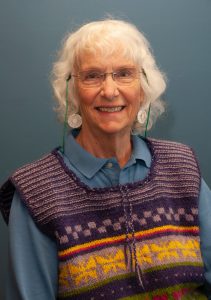 In the past several decades there has been an effort to enable more undergraduates to be involved in original research. Having such experience on their resumes makes students stand out and gives them a clear advantage getting into graduate school and other programs. Opportunities for mentored research are only available on a big university campus to a select few extra-assertive students, but is one of the many ways that FHL can add a valued dimension to undergraduate education – for students from UW or elsewhere. In this month’s Tide Bite, Karly and Cassandra describe their energetic efforts to find resources and create opportunities for undergrads to get quality research experiences at FHL, as well as highlight the ways that students, mentors, and scientific progress benefit.
In the past several decades there has been an effort to enable more undergraduates to be involved in original research. Having such experience on their resumes makes students stand out and gives them a clear advantage getting into graduate school and other programs. Opportunities for mentored research are only available on a big university campus to a select few extra-assertive students, but is one of the many ways that FHL can add a valued dimension to undergraduate education – for students from UW or elsewhere. In this month’s Tide Bite, Karly and Cassandra describe their energetic efforts to find resources and create opportunities for undergrads to get quality research experiences at FHL, as well as highlight the ways that students, mentors, and scientific progress benefit.
As highlighted in the article, “Investing in undergraduate research isn’t a side project, it’s how our science grows.” To support students underrepresented in marine science, click here to make a gift to the Anne Hof Blinks Fellowship in Marine Biology.
Best,
Dr. Megan Dethier, FHL Director
Make your gift today
Investing in Undergraduate Research at FHL
by Karly E. Cohen and Cassandra M. Donatelli
Summer at UW Friday Harbor Laboratories is alive with energy. On any given day you might find students crowding the dock to unload gear from a skiff, or gathered around the CT scanner late into the night as another fish skeleton is rendered in 3D. Flume tanks run, histology ovens hum, and hallways are filled with the mix of excitement and exhaustion that comes from doing science on a campus that is open and accessible to students around the clock. What makes this contagious energy at FHL so remarkable is that it’s fueled not only by senior scientists, but by undergraduate researchers as well. Students work with equipment like µCT scanners, scanning electron microscopes, hydrodynamic flumes, and 3D printers to answer their own scientific questions and get hands-on experience that they might not encounter anywhere else.
What’s great about undergrad research at FHL is how much it changes people. A lot of students show up not really sure if science is their thing, and by the end of the summer – through our classes, the Blinks Research Experience for Undergraduates (REU) program, and other research internships – they’re giving talks, writing up results, and actually seeing themselves as scientists. It’s not because everything goes smoothly (science is full of interesting twists and turns) but they get to see what real research looks like, bumps and all. Mentorship is at the core of this transformation. At FHL, various faculty, postdocs, and graduate students invest time in guiding undergraduates through the process. This mentorship is what builds the strong sense of community that FHL is known for: students don’t just learn from mentors, they become part of a team – contributing to ongoing projects and shaping their own.
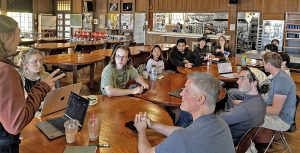 Undergraduate research opportunities don’t happen by accident. They rely on a patchwork of support: fellowships like the Adopt-A-Student Fund and the Kozloff Undergraduate Endowment, competitive awards such as Mary Gates Research Scholarships and Blinks Fellowships, and national programs like the NSF Research Experience for Undergraduates (REU). For this year, we (Karly Cohen and Cassandra Donatelli) began applying for these fellowships in November of 2024. Over this winter and spring we pieced together nearly $30,000 in funding – a mix of institutional, private, and national support – to invest in undergraduate research. That funding went straight into student stipends, housing, travel, and materials, and in turn it supported eight undergraduates in our lab this summer. Every gift and award, whether for a boat trip or a full summer scholarship, directly ensured that undergraduate research remained at the heart of FHL.
Undergraduate research opportunities don’t happen by accident. They rely on a patchwork of support: fellowships like the Adopt-A-Student Fund and the Kozloff Undergraduate Endowment, competitive awards such as Mary Gates Research Scholarships and Blinks Fellowships, and national programs like the NSF Research Experience for Undergraduates (REU). For this year, we (Karly Cohen and Cassandra Donatelli) began applying for these fellowships in November of 2024. Over this winter and spring we pieced together nearly $30,000 in funding – a mix of institutional, private, and national support – to invest in undergraduate research. That funding went straight into student stipends, housing, travel, and materials, and in turn it supported eight undergraduates in our lab this summer. Every gift and award, whether for a boat trip or a full summer scholarship, directly ensured that undergraduate research remained at the heart of FHL.
The payoff has been incredible. Every one of our students is taking their work to a conference, and some are already on track to publish – joining a growing list of undergraduates from our labs who have made real contributions to the field (Arnette et al. 2024 and 2025; Carr et al. 2021; Donatelli et al. 2021 and 2025; Hall et al. 2022; Hoover et al. 2023; Kolmann et al. 2020; Naughton et al. 2021; Rosen et al. 2025; Vandenberg et al. 2024; Woodruff et al. 2022; Woodworth et al. 2025). More importantly, they leave here with the confidence to call themselves scientists. Here’s a look at what they worked on this summer:
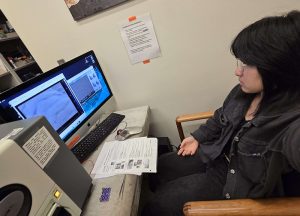 Antifouling & Hydrodynamics (Ellen Pak – UW Tacoma, Biomedical Sciences): Ellen examined the microscopic textures of fish scales and tested how mucus and scale shape interact to reduce drag and prevent fouling. Their goal is to describe the diversity of biological surface structures in the Salish Sea to inspire antifouling surfaces.
Antifouling & Hydrodynamics (Ellen Pak – UW Tacoma, Biomedical Sciences): Ellen examined the microscopic textures of fish scales and tested how mucus and scale shape interact to reduce drag and prevent fouling. Their goal is to describe the diversity of biological surface structures in the Salish Sea to inspire antifouling surfaces.
Built to Burrow: Sand Lance Vertebrae (Elynore [Ellie] In, Owen Proulx – UW Seattle, Marine Biology, Tatiana Egbert – UW Bothell): Ellie, Owen, and Tatiana used CT scans, kinematics, and bioinspired soft robotic models to reveal how sand lance dive head-first into the sand. Their work showed that sand lance have evolved to accomplish this biomechanical challenge through a combination of morphological and behavioral adaptations. Their vertebrae change shape as they grow and are also denser at the head and tail, making them more efficient swimmers and resistant to the forces of burrowing. They also showed that the jaws become highly mineralized with growth, forming a wedge-like tool for cracking into sediment. These students’ work revealed how sand lance turn a fragile-looking body into a powerful digging machine.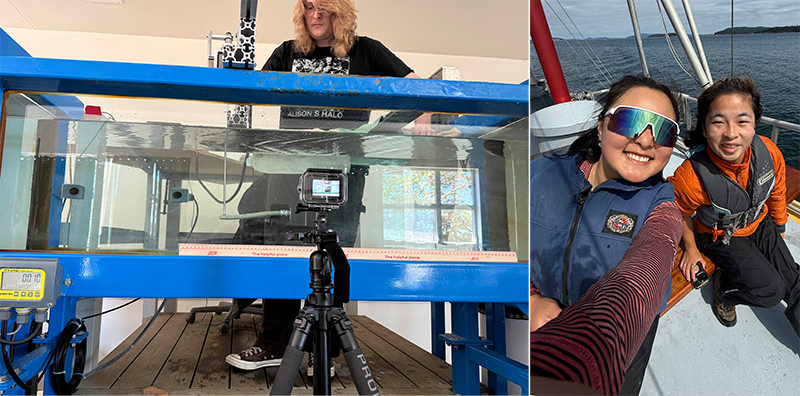
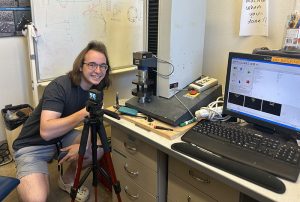 Scales under Pressure (Brody Andersen – Washington State University, Biological Sciences): Brody was inspired this summer by armored fishes, specifically poachers. By 3D-printing models of their armored scales, he discovered that the geometric arrangement of scales and joints in poachers resist compression more effectively than traditional engineering designs. His work shows not only how armor has evolved to protect the fish as it squeezes under rocks, but also how we might design armor for underwater exploration.
Scales under Pressure (Brody Andersen – Washington State University, Biological Sciences): Brody was inspired this summer by armored fishes, specifically poachers. By 3D-printing models of their armored scales, he discovered that the geometric arrangement of scales and joints in poachers resist compression more effectively than traditional engineering designs. His work shows not only how armor has evolved to protect the fish as it squeezes under rocks, but also how we might design armor for underwater exploration.
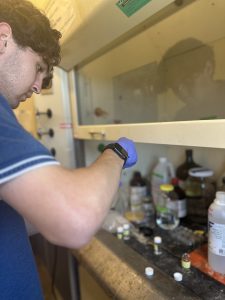 Soft Tissue in Armor (Lorenzo Martinez – Rhodes College, Biology): Lorenzo was an REU student at FHL in the 2024 cohort where he studied the way poacher scales respond to different types of damage. This summer, he returned to explore the connective tissue between armored plates. He combined histology with multi-material 3D printing to show how collagen and connective tissues allow rigid armor to bend without breaking. This work highlights the hidden flexibility in what looks like an all-bone suit of armor.
Soft Tissue in Armor (Lorenzo Martinez – Rhodes College, Biology): Lorenzo was an REU student at FHL in the 2024 cohort where he studied the way poacher scales respond to different types of damage. This summer, he returned to explore the connective tissue between armored plates. He combined histology with multi-material 3D printing to show how collagen and connective tissues allow rigid armor to bend without breaking. This work highlights the hidden flexibility in what looks like an all-bone suit of armor.
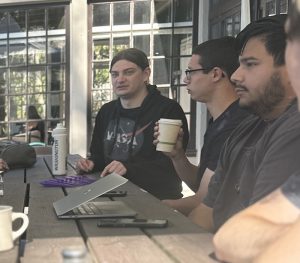 Hydrodynamics of Armor Shapes (Jonah Armendariz and Nolan Sankey – UW Tacoma, Mechanical Engineering): Jonah and Sankey used CT scans of 11 poacher species to describe the diversity of body shape in the group. They used their data to build and 3D-print models spanning this diversity, and tested them in a flow flume to measure how small differences in body shape affect drag. These results show how fish armor shapes flow, with the goal of inspiring more efficient underwater vehicle design.
Hydrodynamics of Armor Shapes (Jonah Armendariz and Nolan Sankey – UW Tacoma, Mechanical Engineering): Jonah and Sankey used CT scans of 11 poacher species to describe the diversity of body shape in the group. They used their data to build and 3D-print models spanning this diversity, and tested them in a flow flume to measure how small differences in body shape affect drag. These results show how fish armor shapes flow, with the goal of inspiring more efficient underwater vehicle design.
The infrastructure and resources maintained by Adam Summers in Lab 8 – imaging facilities, flumes, and maker spaces – expand the reach of undergraduate projects across FHL. Students also found mentorship with Bart Boom, John Michael Racy, Megan Vandenberg, Ed Habtour, Tadd Truscott, Graham Short, and Roi Holzman:
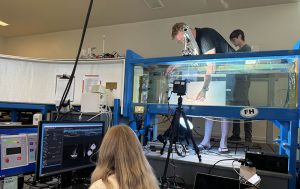 Batoid movement and hydrodynamics (Alex Kaplan – UC Santa Cruz, John Michael Racy – UW Seattle): Skates are bottom-dwelling relatives of sharks and rays that use graceful wing-like fins to glide along the seafloor. Inside the fins, skeletal supports called fin rays vary between groups. Skates rely entirely on the external shape and internal structure of their fins to control swimming, but it is unclear the exact relationship between shape and performance. Alex and John created 3D-printed models of skates which mimic both real life external shape and internal skeletal structure, and tested them in a flow tank to measure how their shape interacts with moving water. The results show that skates’ wide, flattened bodies naturally generate passive stability which helps them stay level and resist tipping. Their body design itself, not just active fin motions, contributes to efficient swimming. Alex and John were mentored by Bart and Megan.
Batoid movement and hydrodynamics (Alex Kaplan – UC Santa Cruz, John Michael Racy – UW Seattle): Skates are bottom-dwelling relatives of sharks and rays that use graceful wing-like fins to glide along the seafloor. Inside the fins, skeletal supports called fin rays vary between groups. Skates rely entirely on the external shape and internal structure of their fins to control swimming, but it is unclear the exact relationship between shape and performance. Alex and John created 3D-printed models of skates which mimic both real life external shape and internal skeletal structure, and tested them in a flow tank to measure how their shape interacts with moving water. The results show that skates’ wide, flattened bodies naturally generate passive stability which helps them stay level and resist tipping. Their body design itself, not just active fin motions, contributes to efficient swimming. Alex and John were mentored by Bart and Megan.
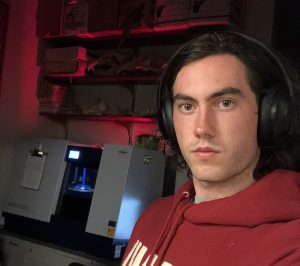 Evolution of springs and jaws in seahorses (Alexander DuToit – UMass Amherst): Alexander was an REU mentored remotely by Roi Hozman (University of Tel Aviv) and locally by Graham Short (California Academy of Sciences) and supervised by Karly and Cassandra. Alexander investigated how seahorses and their relatives generate some of the fastest feeding strikes in the ocean. Using μCT scans of 30 species across five families of Syngnathoidei, he measured key bones involved in suction feeding and mapped their evolution. His work revealed that seahorses have added a second “spring” to the system: an elongated sternohyoid tendon that supplements the epaxial tendon, making their strikes even more powerful. Alexander also found that in some pipefishes, the epaxial tendon has ossified, or become impregnated with mineral, which limits high-powered strikes. These results show how tendon and bone evolution shape extreme feeding performance across this diverse clade.
Evolution of springs and jaws in seahorses (Alexander DuToit – UMass Amherst): Alexander was an REU mentored remotely by Roi Hozman (University of Tel Aviv) and locally by Graham Short (California Academy of Sciences) and supervised by Karly and Cassandra. Alexander investigated how seahorses and their relatives generate some of the fastest feeding strikes in the ocean. Using μCT scans of 30 species across five families of Syngnathoidei, he measured key bones involved in suction feeding and mapped their evolution. His work revealed that seahorses have added a second “spring” to the system: an elongated sternohyoid tendon that supplements the epaxial tendon, making their strikes even more powerful. Alexander also found that in some pipefishes, the epaxial tendon has ossified, or become impregnated with mineral, which limits high-powered strikes. These results show how tendon and bone evolution shape extreme feeding performance across this diverse clade.
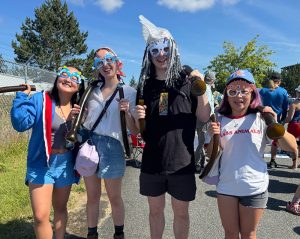 Over the past five years, we have sent more than 80 undergraduates to conferences, co-authored 13 peer-reviewed papers with them, watched students go on to graduate school across the country, and celebrated major achievements like Graduate Research Fellowship Program awards from the National Science Foundation.
Over the past five years, we have sent more than 80 undergraduates to conferences, co-authored 13 peer-reviewed papers with them, watched students go on to graduate school across the country, and celebrated major achievements like Graduate Research Fellowship Program awards from the National Science Foundation.
By the end of this summer, the dock was quieter and the scanners stood still, but the impact of the season endures. Students carried their projects back to their home institutions, mentors gained collaborators who brought fresh energy and new ideas, and FHL itself continues the cycle that has defined it for generations: bringing undergraduates into the heart of marine research, and building a community grounded in discovery.
References:
Arnette S.D., Donatelli C.M., Rosen J., Hawkins O.H., and J.M. Huie. 2025. Clinging for Shear Life: Active Input Improves Adhesion in the Northern Clingfish. Integrative and Comparative Biology, icaf120. https://doi.org/10.1093/icb/icaf120
Arnette S.D., Simonitis L.E., Egan J.P., Cohen K.E., and M.A. Kolmann. 2024. True grit? Comparative anatomy and evolution of gizzards in fishes. Journal of Anatomy, 244(2), 260–273. https://doi.org/10.1111/joa.13956
Carr E.M., Summers A.P., and K.E. Cohen. 2021. The moment of tooth: Rate, fate and pattern of Pacific lingcod dentition revealed by pulse-chase. Proceedings of the Royal Society B: Biological Sciences, 288(1960), 20211436. https://doi.org/10.1098/rspb.2021.1436
Donatelli C.M., Roberts A.S., Scott E., DeSmith K., Summers D., Abu-Bader L., Baxter D., Standen E.M., Porter M.E., Summers A.P., and E.D. Tytell. 2021. Foretelling the Flex—Vertebral Shape Predicts Behavior and Ecology of Fishes. Integrative and Comparative Biology, 61(2), 414–426. https://doi.org/10.1093/icb/icab110
Donatelli C.M., Vandenberg M.L., Martinez L.E., Schulz A.K., Paig-Tran E.W.M., and K.E. Cohen. 2025. The Bioinspiration Feedback Loop: An Interdisciplinary Exchange of Processes and Progress Between Biologists and Engineers. Integrative and Comparative Biology, icaf128. https://doi.org/10.1093/icb/icaf128
Hall K.C., Elcock J.N., Hoff G.R., Stevenson D.E., Summers A.P., and C.M. Donatelli. 2022. Interspecific Differences in the Flow Regimes and Drag of North Pacific Skate Egg Cases. Integrative and Comparative Biology, 62(3), 805–816. https://doi.org/10.1093/icb/icac108
Hoover R.C., Hawkins O.H., Rosen J., Wilson C.D., Crawford C.H., Holst M.M., Huie J.M., Summers A.P., Donatelli C.M., and K.E. Cohen. 2023. It Pays to Be Bumpy: Drag Reducing Armor in the Pacific Spiny Lumpsucker, Eumicrotremus orbis. Integrative and Comparative Biology, icad076. https://doi.org/10.1093/icb/icad076
Kolmann M.A., Peixoto T., Pfeiffenberger J.A., Summers A.P., and C.M. Donatelli. 2020. Swimming and defence: Competing needs across ontogeny in armoured fishes (Agonidae). Journal of The Royal Society Interface, 17(169), 20200301. https://doi.org/10.1098/rsif.2020.0301
Naughton L.F., Kruppert S., Jackson B., Porter M.E., and C.M. Donatelli. 2021. A Tail of Four Fishes: An Analysis of Kinematics and Material Properties of Elongate Fishes. Integrative and Comparative Biology, 61(2), 603–612. https://doi.org/10.1093/icb/icab060
Rosen J., Cohen K., Donatelli C.M., Summers A., Crofts S., and M. Kolmann. 2025. Something to sink your teeth into: The mechanics of tooth indentation in frugivorous fishes. Journal of The Royal Society Interface, 22(225), 20240725. https://doi.org/10.1098/rsif.2024.0725
Vandenberg M.L., Hawkins O.H., Chier E., Kahane-Rapport S.R., Summers A.P., C.M. Donatelli. 2024. How rugose can you go? Spiny Agonidae armour decreases boundary layer separation. Biological Journal of the Linnean Society, 143(1), blae075. https://doi.org/10.1093/biolinnean/blae075
Woodruff E.C., Huie J.M., Summers A.P., and K.E. Cohen. 2022. Pacific Spiny Lumpsucker armor — Development, damage, and defense in the intertidal. Journal of Morphology, 238(2). https://doi.org/10.1002/jmor.21435
Woodworth B., Palmeri J., Flannery P., Fregosi L., Donatelli C., and M.E. Gerringer. 2025. Swimming kinematics of deep-sea fishes. Journal of Fish Biology, 106(3), 805–822. https://doi.org/10.1111/jfb.15989
Tide Bites is a monthly email with the latest news and stories about Friday Harbor Labs. Want more? Subscribe to Tide Bites or browse the archives.